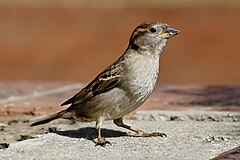Passer
| Passer[1] | |||
| Brisson, 1760[2] | |||
 Samica wróbla zwyczajnego (P. domesticus) | |||
| Systematyka | |||
| Domena | |||
|---|---|---|---|
| Królestwo | |||
| Typ | |||
| Podtyp | |||
| Gromada | |||
| Podgromada | |||
| Infragromada | |||
| Rząd | |||
| Podrząd | |||
| Rodzina | |||
| Podrodzina | |||
| Rodzaj |
Passer | ||
| Typ nomenklatoryczny | |||
|
Fringilla domestica Linnaeus, 1758 | |||
| Synonimy | |||
|
| |||
| Gatunki | |||
| |||
Passer – rodzaj ptaków z podrodziny wróbli (Passerinae) w obrębie rodziny wróbli (Passeridae).
Zasięg występowania
Rodzaj obejmuje gatunki występujące pierwotnie w Eurazji i Afryce[4]. Niektóre gatunki (a zwłaszcza wróbel zwyczajny[5]) introdukowane na inne kontynenty.
Charakterystyka
Długość ciała 10,5–18 cm; masa ciała 11–48 g[6]. Są to ptaki zazwyczaj towarzyskie, niekiedy także synantropijne (np. wróbel zwyczajny). Osiadłe lub koczujące, rzadko wędrowne. Składają do ośmiu jaj wysiadywanych przez 12–14 dni przez oboje rodziców. Młode pierzą się przez 14–24 dni.
Systematyka
Etymologia
- Passer: łac. passer, passeris „wróbel”[7].
- Ammopasser: gr. αμμος ammos „piasek”; łac. passer, passeris „wróbel”[8]. Gatunek typowy: Passer ammodendri Gould, 1872.
Podział systematyczny
Badania filogenetyczne wykazały, że najbardziej bazalne gatunki rodzaju pochodzą z Afryki. Za najstarszy gatunek uznany został Passer melanurus. Passer nie należy do trznadli (Emberizinae), co dawniej sugerowano, jest jednak z nimi blisko spokrewniony[9]. Do rodzaju należą następujące gatunki[10]:
- Passer pyrrhonotus Blyth, 1845 – wróbel pakistański
- Passer cinnamomeus (Gould, 1836) – wróbel cynamonowy
- Passer ammodendri Gould, 1872 – wróbel mongolski
- Passer iagoensis (Gould, 1838) – wróbel rudogrzbiety
- Passer zarudnyi Pleske, 1896 – wróbel popielaty
- Passer simplex (M.H.C. Lichtenstein, 1823) – wróbel pustynny
- Passer moabiticus Tristram, 1864 – wróbel palestyński
- Passer luteus (M.H.C. Lichtenstein, 1823) – wróbel cytrynowy
- Passer euchlorus (Bonaparte, 1850) – wróbel złoty
- Passer montanus (Linnaeus, 1758) – mazurek
- Passer flaveolus Blyth, 1845 – wróbel oliwkowy
- Passer insularis P.L. Sclater & Hartlaub, 1881 – wróbel szarogrzbiety
- Passer hispaniolensis (Temminck, 1820) – wróbel śródziemnomorski
- Passer domesticus (Linnaeus, 1758) – wróbel zwyczajny
- Passer italiae (Vieillot, 1817) – wróbel apeniński – takson ten (P. hispaniolensis × P. domesticus) jest coraz bardziej uznawany jako przykład hybrydowej specjacji[11][12]
- Passer castanopterus Blyth, 1855 – wróbel rudogłowy
- Passer cordofanicus von Heuglin, 1874 – wróbel sudański
- Passer motitensis (A. Smith, 1836) – wróbel rdzawy
- Passer eminibey (Hartlaub, 1880) – wróbel kasztanowaty
- Passer melanurus (Statius Müller, 1776) – wróbel czarnogłowy
- Passer griseus (Vieillot, 1817) – wróbel siwogłowy
- Passer diffusus (A. Smith, 1836) – wróbel blady
Przypisy
- ↑ Passer, [w:] Integrated Taxonomic Information System (ang.).
- ↑ M.J. Brisson: Ornithologie, ou, Méthode contenant la division des oiseaux en ordres, sections, genres, especes & leurs variétés: a laquelle on a joint une description exacte de chaque espece, avec les citations des auteurs qui en ont traité, les noms quils leur ont donnés, ceux que leur ont donnés les différentes nations, & les noms vulgaires. T. 1. Paryż: Ad Ripam Augustinorum, apud Cl. Joannem-Baptistam Bauche, bibliopolam, ad Insigne S. Genovesae, & S. Joannis in Deserto, 1760, s. 36. (fr.).
- ↑ N.A. Zarudny. Орнитологическая фауна области Аму-Дарьи между гг. Чарджуемъ и Келифoмъ. „Bulletin de la Société impériale des naturalistes de Moscou”. Nouvelle série. 4, s. 9, 20, 1890. (ros.).
- ↑ F. Gill, D. Donsker & P. Rasmussen (red.): IOC World Bird List (v11.2). [dostęp 2021-07-25]. (ang.).
- ↑ Passer domesticus, [w:] The IUCN Red List of Threatened Species [dostęp 2021-07-25] (ang.).
- ↑ D.W. Winkler, S.M. Billerman & I.J. Lovette: Old World Sparrows (Passeridae), version 1.0. W: S.M. Billerman, B.K. Keeney, P.G. Rodewald & T.S. Schulenberg (redaktorzy): Birds of the World. Ithaca, NY: Cornell Lab of Ornithology, 2021. DOI: 10.2173/bow.passer4.01. [dostęp 2021-07-22]. (ang.).

- ↑ Passer, [w:] The Key to Scientific Names, J.A. Jobling (red.), [w:] Birds of the World, S.M. Billerman et al. (red.), Cornell Lab of Ornithology, Ithaca [dostęp 2022-01-17] (ang.).
- ↑ Ammopasser, [w:] The Key to Scientific Names, J.A. Jobling (red.), [w:] Birds of the World, S.M. Billerman et al. (red.), Cornell Lab of Ornithology, Ithaca [dostęp 2022-01-17] (ang.).
- ↑ L.M. Allende, I. Rubio, V. Ruız-del-Valle, J. Guillen, J. Martınez-Laso, E. Lowy, P. Varela, J. Zamora, A. Arnaiz-Villena. The Old World Sparrows (Genus Passer) Phylogeography and Their Relative Abundance of Nuclear mtDNA Pseudogenes. „Journal of Molecular Evolution”. 53 (2), s. 144–154, 2001. DOI: 10.1007/s002390010202. (ang.).
- ↑ Systematyka i nazwy polskie za: P. Mielczarek & M. Kuziemko: Rodzina: Passeridae Rafinesque, 1815 – wróble – Sparrows, snowfinches and allies (wersja: 2024-10-21). [w:] Kompletna lista ptaków świata [on-line]. Instytut Nauk o Środowisku Uniwersytetu Jagiellońskiego. [dostęp 2024-11-29].
- ↑ T.O. Elgvin, J.S. Hermansen, A. Fijarczyk, T. Bonnet, T. Borge, S.A. Sæther, K.L. Voje & G.-P. Sætre. Hybrid speciation in sparrows II: a role for sex chromosomes?. „Molecular Ecology”. 20 (18), s. 3823–3837, 2011. DOI: 10.1111/j.1365-294X.2011.05182.x. (ang.).
- ↑ J.S. Hermansen, S.A. Sæther, T.O. Elgvin, T. Borge, E. Hjelle & G.-P. Sætre. Hybrid speciation in sparrows I: phenotypic intermediacy, genetic admixture and barriers to gene flow. „Molecular Ecology”. 20 (18), s. 3812–3822, 2011. DOI: 10.1111/j.1365-294X.2011.05183.x. (ang.).
